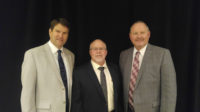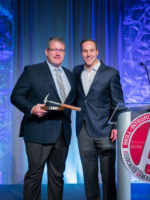Utah AGC Members See Strong Markets But Workforce Issues Persist
Members gather for annual convention and bid farewell to longtime leader

AGC of Utah 2022 Board Chair Troy Thompson passes the gavel to 2023 Board Chair Scott Parson.
Courtesy AGC of Utah
Members of the Utah Chapter of the Associated General Contractors of America gathered for the association’s 101st annual convention at the Little America Hotel in Salt Lake City. Just over 500 members and associates arrived each day for awards, workshops, installation of new officers and to bid farewell to retiring chapter president and CEO Rich Thorn who has led the organization for 42 years. Joey Gilbert, who has served as vice-president under Thorn for 15 years, will assume the leadership role in March.
“I couldn’t be happier with the way things are transitioning. I have full faith and confidence in Joey and the staff. For me, this last convention is a chance to shake some hands and say good-bye to some old friends,” Thorn says.
At the Friday night closing banquet, Thorn was presented with the association’s Eric W. Ryberg Award for Excellence and Dedication. Thorn was also recently named ENR Mountain States 2023 Legacy Award winner, and an article showcasing his AGC career will appear in the February issue of ENR Mountain States.
Scott Parson, CEO of Ogden-based Staker Parson Cos., was installed as board chairman for 2023 taking over for Troy Thompson, vice president and COO at Salt Lake City-based Big-D Construction. Parson follows in the footsteps of his grandfather Jack B. Parson and his father Jack B. Parson Jr., who both served as chairman of the board.
Parson said during his tenure he plans to review the strategic plans and programs that have directed the association and ensure the foundational principles are sound going forward.
“Starting our 101st year, I think it is an opportunity to look at the strategy of some of our programs and our strategic plan and make sure we’re on the right track moving forward,” Parson says. “I’m looking forward to collaborating and working with the board on the challenges we face.”
Parson and Thompson agreed the greatest challenge to the association and the AEC industry remains workforce development. Both say they are hopeful that the new AGC Training Center, which opened last year in adjacent to the association’s office in Salt Lake City, can help in recruitment for apprenticeships and improving the skills of current workers.
“We need to reimagine and reinvent our approach to attracting and keeping workers,” Parson says. “I’d like to develop new ways to use our resources to broaden our understanding of students and young people. I think we also need to extend our work with counselors and others guiding young people so they understand the opportunities in our industry.”
Legislative Work
Gilbert is leading the association’s lobbying work at the state legislature which began its 45-day session the same week as the convention. Gilbert says, in an effort to boost workforce development, the AGC is supporting a measure that would provide insurance coverage through the state for high-school aged workers doing internships and allow them to be paid for their work by the contractor. Currently students are only covered when enrolled in an unpaid internship program.
The association is also supporting a bill that would change the way fees collected from aggregate producers are distributed.
“Currently, the money those operations pay is divided among all cities and towns in the state. This bill would change it so that only towns with aggregate production facilities, the ones who see the most wear-and-tear on their roads, would be eligible for those funds,” he says.
Cautiously Optimistic
Speaking in his role as vice president and COO at Big-D, Thompson says that while the company has seen a slowdown in its multifamily residential building, all other sectors remain strong.
“We have one of our largest backlogs ever,” he says. “Last year we started a new heavy-industrial division that is working mostly in the mining sector. We are building the vertical and horizontal infrastructure for mining operations in this region, and they are all very busy now.”
Todd Hughes, president of Hughes Construction based in North Salt Lake City, says the outlook is positive for him as well.
“We do a lot of schools and tilt-up concrete buildings, and both those sectors are really strong for us,” he says. “In fact, we’re seeing some cross-over as more schools are using tilt-up in their projects.”
Hughes says the concrete shortages that delayed projects during the summer have eased.
In Southern Utah, Doug Watts, vice president of Watts construction based in St. George, says housing construction in the area seems to have slowed but the commercial work is continuing at a vigorous pace.
“There are a lot of mid-size, five to six million dollar, jobs in our area,” says Watts, whose firm just completed the new $24 million offices for Washington County. “Schedules have been getting longer and we’ve seen price escalations but that doesn't seem to have stopped any projects.”




